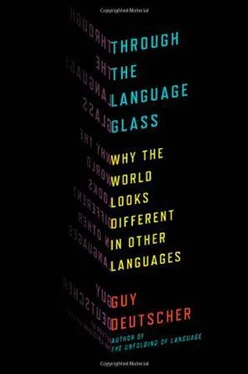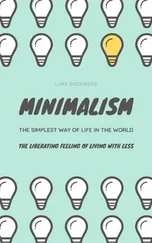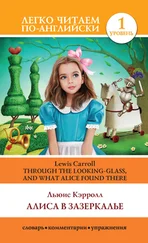But things quickly become less cozy when it transpires that culture interferes not just in the realm of abstraction but also in the simplest concepts of everyday discourse. Take pronouns such as “I,” “you,” or “we.” Could anything be more elementary or more natural than these? Of course, no one who is aware of the existence of foreign languages would be under the illusion that the labels for such concepts are dictated by nature, but it seems unimaginable that any language would not have the actual concepts themselves. Suppose, for instance, you continue thumbing through the travelogue and come across the claim that Ziftish doesn’t have a word that corresponds to English “we.” Instead, the author alleges, Ziftish has three distinct pronouns: kita , which means “just the two of us, me and you,” tayo , which means “me and you and someone else,” and kami , which means “me and someone else, but not you.” The author relates how tickled the Ziftians were to hear that for these three entirely different concepts English uses just one little word, a wee “we.” You may dismiss the system our chimerical author has invented as a lame joke, but Tagalog speakers in the Philippines would disagree, because this is exactly how they speak.
The strain on plain common sense is only just beginning, though. One might naturally expect that at least the concepts that describe simple physical objects would all be the prerogative of nature. As long as we restrict ourselves to cats, dogs, and birds, this expectation is in fact largely borne out, because these animals are so distinctly shaped by nature. But the moment nature shows the slightest doubt in its incision, culture is quick to pounce. Consider the parts of the human body, for instance. Among the simple physical things that matter most to our lives, it hardly gets any simpler or more physical than hands and toes and fingers and necks. And yet many of these allegedly distinct body parts were not delineated by nature with much zeal. The arm and the hand, for example, are the body’s equivalent to the continents Asia and Europe-are they really one thing or two? It turns out that the answer depends on the culture you grew up in. There are many languages, my mother tongue included, that treat the hand and the arm as one concept and use the same label for both. If a Hebrew speaker tells you that when she was a child she got an injection in her hand, this is not because her doctors were sadistic, but simply because she is thinking in a language that doesn’t make the distinction as a matter of course, so she has forgotten to use a different word for that particular part of the hand that English curiously insists on calling an “arm.” On the other arm, there was a fairly long period when my daughter, who had learned that yad in Hebrew meant “hand,” objected loudly whenever I used yad to refer to the arm, even when we spoke in Hebrew. She would point at the arm and explain to me in indignant tones: ze lo yad (it’s not yad ), ze arm (it’s “arm”)! The fact that “hand” and “arm” are different things in one language but the same thing in another is not so easy to grasp.
There are also languages that use the same word for “hand” and “finger,” and a few languages, such as Hawaiian, even manage with using just one concept for the three distinct English body parts “arm,” “hand,” and “finger.” Conversely, English lumps together certain body parts that speakers of other languages treat as distinct concepts. Even after two decades of speaking English, I still sometimes get tied up in knots with the neck. Someone starts talking about his neck, and I naturally take him at his word and assume he really means his neck-the part of the body that in my mother tongue is called tsavar . But after a while it transpires that he hasn’t been talking about the neck at all. Or rather, he was talking about the neck, but he didn’t mean the tsavar . What he actually meant was oref , the “back of the neck,” that body part which English most carelessly and inconsiderately conjoins with the front of the neck into one concept. In Hebrew, the neck ( tsavar ) refers only to the front part of this tube, whereas the back part, oref , has an entirely unrelated name and is considered just as distinct as the English “back” is from “belly” or “hand” is from “arm.”
Nature’s concessions to culture are now starting to feel a little more grudging. While it is hardly unsettling that abstract concepts such as “mind,” or “esprit,” are culturally dependent, we are getting to the edge of the comfort zone with the notion that pronouns like “we” or body parts like “hand” or “neck” all depend on the particular cultural conventions of our society. But if the forays of culture into the realm of concepts are beginning to hurt a little, all this is but a pinprick compared with the pains caused by culture’s interference in the area that will occupy us in the first part of the book. In this field of language, culture’s incursion into the land of concepts so offended, even outraged, plain common sense that for decades the defenders of nature were mobilized to fight to their last drop of ink to uphold her cause. In consequence, this enclave has been at the center of a 150-year war between the proponents of nature and of culture, a conflict that is showing no sign of abating. This battleground is the language of color.
Why should color, of all things, be at the center of so much crossfire? Perhaps because in meddling with such a deep and seemingly instinctive area of perception, culture camouflages itself as nature more successfully there than in any other area of language. There is nothing remotely abstract, theoretical, philosophical, hypothetical, or any other -cal, so it seems, about the difference between yellow and red or between green and blue. And since colors are on the ground level of perception, the concepts of color would appear to be the prerogative of nature. And yet nature has been rather negligent in staking out her boundaries on the spectrum. The colors form a continuum: green does not become blue at any definite point, but blurs gradually into blue through millions of shades of teal, turquoise, and aquamarine (see figure 1). When we speak about colors, however, we impose distinct boundaries on this variegated swathe: “yellow,” “green,” “blue,” and so on. But is our particular way of dividing the color space a dictate of nature? Are the concepts “yellow” or “green” universal constants of the human race that were decreed by the biological makeup of the eye and brain? Or are they arbitrary cultural conventions? Could the boundaries have been set differently? And why should anyone dream up such abstruse hypothetical questions anyway?
As it happens, the controversy over the concepts of color was not conjured up by any abstract philosophical ruminations but arose in the wake of entirely practical observations. A series of discoveries made in the middle of the nineteenth century led to the startling revelation that mankind’s relation to color has not always been as clear as it seems to us now, and that what appears obvious to us caused no end of difficulty to the ancients. The ensuing mission to discover the source of the “color sense” is a gripping Victorian adventure story, an episode in the history of ideas that can rival the derring-do of any nineteenth-century explorer. The color expedition reached the remotest corners of the earth, got tangled up with the fiercest controversies of the day-evolution, heredity, and race-and was driven by a motley cast of unlikely heroes: a celebrated statesman whose intellectual feats are now almost entirely unknown, an Orthodox Jew who was led by his philological discoveries to the most heterodox evolutionary thoughts, an eye doctor from a provincial German university who set a whole generation in pursuit of a bright red herring, and a Cambridge don, dubbed the “Galileo of anthropology,” who finally put the quest back on course, against his own better judgment.
Читать дальше











